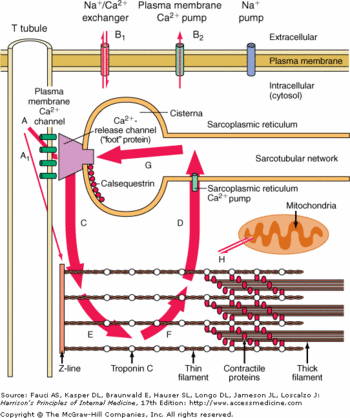Sandbox Reserved 820
From Proteopedia
(Difference between revisions)
| Line 26: | Line 26: | ||
There are two types of dimerisation: the front-to-front form and the back-to-back form. | There are two types of dimerisation: the front-to-front form and the back-to-back form. | ||
The front-to-front form is stabilized by intermolecular interactions between the | The front-to-front form is stabilized by intermolecular interactions between the | ||
| - | <scene name='56/568018/Dimer/3'>α2 helix of the domain I</scene> of each CASQ2. The intermolecular salt bridges are between Glu 55 and Lys 49. This dimerisation induces the formation of an electronegative pocket which involves these amino acids: for the first CASQ2 Glu 39, Glu 54, Glu 78, Glu 92, Asp 93 and Asp 101 and for the second CASQ2 Glu 199, Asp 245, Asp 278, Glu 350 and Glu 348. <!--Mettre du VERT --> | + | <scene name='56/568018/Dimer/3'>α2 helix of the domain I</scene> of each CASQ2. The intermolecular salt bridges are built between <scene name='56/568018/Dimer/6'>Glu 55 and Lys 49</scene>. This dimerisation induces the formation of an electronegative pocket which involves these amino acids: for the first CASQ2 Glu 39, Glu 54, Glu 78, Glu 92, Asp 93 and Asp 101 and for the second CASQ2 Glu 199, Asp 245, Asp 278, Glu 350 and Glu 348. <!--Mettre du VERT --> |
The back-to-back form is stabilized by intermolecular interactions between the α4 helix of the domain II and the α3 helix of the domain I. The intermolecular salt bridges are between Glu 215 and Lys 86, Glu 216 and Lys 24, Glu 169 and Lys 85. There is also a hydrogen bond between Ala 82 and Asn 22. This dimerisation induces a very electronegative pocket at the C-terminal region which enables the binding of Ca2+. | The back-to-back form is stabilized by intermolecular interactions between the α4 helix of the domain II and the α3 helix of the domain I. The intermolecular salt bridges are between Glu 215 and Lys 86, Glu 216 and Lys 24, Glu 169 and Lys 85. There is also a hydrogen bond between Ala 82 and Asn 22. This dimerisation induces a very electronegative pocket at the C-terminal region which enables the binding of Ca2+. | ||
Revision as of 12:32, 2 January 2014
| This Sandbox is Reserved from 06/12/2018, through 30/06/2019 for use in the course "Structural Biology" taught by Bruno Kieffer at the University of Strasbourg, ESBS. This reservation includes Sandbox Reserved 1480 through Sandbox Reserved 1543. |
To get started:
More help: Help:Editing |
| |||||||||||

